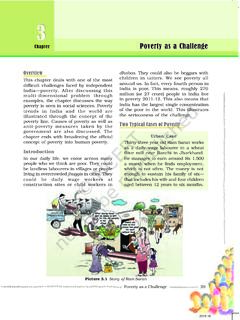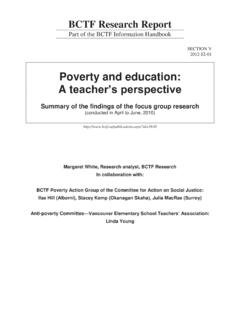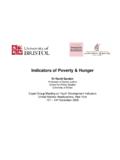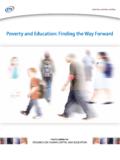Transcription of POVERTY MEASUREMENT IN INDIA
1 Ministry of Rural Development Working Paper No. 1/2020 POVERTY MEASUREMENT IN INDIA : A STATUS UPDATE Dr. SEEMA GAUR & Dr. N SRINIVASA RAO September 2020 Note: Authors are Principal Economic Adviser and Economic Adviser respectively in the Department of Rural Development. 2 Abstract This paper provides an overview of estimation of POVERTY by various expert groups in INDIA . It also discusses the limitations of below POVERTY line (BPL) approach in INDIA . It also provides an overview of other POVERTY measures at international level particularly Global Multidimensional POVERTY Index (MPI) and their assessment about INDIA . The paper concludes by reviewing present approaches and options for POVERTY MEASUREMENT .
2 Disclaimer: Views expressed in this paper are exclusively of the author(s) and not of any other individual or the Ministry of Rural Development. It has been prepared in good faith on the basis of information available at the date of publication. 3 1. INTRODUCTION POVERTY elimination has remained a major challenge right from independence and lies at the core of INDIA 's national development agenda to create a just and equitable society. Given the limited resources, reliable estimation of POVERTY is the first step towards eradication of POVERTY as a basic input for design, implementation and monitoring of anti POVERTY programmes. POVERTY MEASUREMENT is also important to serve as a barometer of the extent of the success of strategies for inclusive growth and POVERTY reduction.
3 POVERTY can be defined as a condition in which an individual or household lacks the financial resources to afford a basic minimum standard of living. However, the perception regarding what constitutes POVERTY may vary over time and across countries. The conventional approach to measuring POVERTY is to specify a minimum expenditure (or income) required to purchase a basket of goods and services necessary to satisfy basic human needs. This expenditure is called the POVERTY line. The basket of goods and services necessary to satisfy basic human needs is the POVERTY Line Basket (PLB). POVERTY can be measured in terms of the number of people living below this line (with the incidence of POVERTY expressed as the head count ratio (HCR) or the POVERTY ratio - number of poor to the total population expressed as percentage).
4 Globally, countries use different measures for measuring POVERTY but the underlying principle remains the same - a POVERTY line is calculated based on of consumption required for maintaining some minimum standard of living in the country. However, complexities of measuring incidence of POVERTY in a comparable manner over time and across regions have given rise to alternative approaches also such as measures of the depth of POVERTY and of its severity. 2. METHODOLOGY OF ESTIMATION INDIA has a long history of studies on MEASUREMENT of POVERTY . The erstwhile Planning Commission was the nodal agency in INDIA for estimation of POVERTY . Based on the methodology suggested by the Expert Groups/Committees set up by the Planning Commission from time to time, INDIA has undertaken periodic assessments of the incidence of POVERTY since the 1960s.
5 The POVERTY ratio in INDIA has been measured from an exogenously determined POVERTY line quantified in terms of per capita consumption expenditure over a month and the class distribution of persons obtained from the large sample survey of consumer expenditure data of the National Sample Survey Office (NSSO). Households with consumption expenditures below the POVERTY line are said to be Below the POVERTY Line (BPL) and deemed poor. Consumption is measured in terms of a collection of goods and services known as reference POVERTY Line Baskets (PLB). Thus, estimation of POVERTY in INDIA has been based on two critical components: 4 Information on the consumption expenditures and its distribution across households is provided by the NSS consumption expenditure surveys; These expenditures by households are evaluated with reference to a given POVERTY line.
6 A) POVERTY Line Estimation The first step in estimating POVERTY is to define and quantify a POVERTY line. Pre-Independence POVERTY Estimation i) POVERTY and Unbritish Rule in INDIA (1901): Dadabhai Naoroji in his book POVERTY and Un-British Rule in INDIA , made the earliest estimate of POVERTY line at 1867-68 prices ( 16 to 35 per capita per year) based on the cost of a subsistence diet for the emigrant coolies during their voyage living in a state of quietude. ii) National Planning Committee s (1938): In 1938, the National Planning Committee set up under the chairmanship of Jawaharlal Nehru suggested a POVERTY line (ranging from 15 to 20 per capita per month) based on a minimum standard of living. iii) The Bombay Plan (1944): Bombay Plan1 proponents suggested a POVERTY line of 75 per capita per year, which was much more modest than that of the NPC.
7 Post- Independence POVERTY Estimation Various expert groups constituted by the Planning Commission have estimated the number of people living in POVERTY in INDIA : i) Working Group (1962): The POVERTY line in INDIA was quantified for the first time in 1962 by this Group in terms of a minimum requirement (food and non-food) of individuals for healthy living. The Group appeared to have taken into account the recommendation of balanced diet made by the Nutrition Advisory Group of the Indian Council of Medical Research (ICMR) in 1958. The Group formulated the separate POVERTY lines for rural and urban areas ( 20 and 25 per capita per month respectively in terms of 1960-61 prices) without any regional variation.
8 The POVERTY line excluded expenditure on health and education, both of which, it was assumed, were to be provided by the State. Although not official POVERTY lines, these were widely used in the 1960s and 1970s to estimate the POVERTY ratio at national and state level. ii) Study by VM Dandekar and N Rath (1971): Although this was not a study commissioned by the Planning Commission, the origins of INDIA s POVERTY line lie in the seminal work of two economists, V N Dandekar and N Rath, who first established the consumption levels required to meet a minimum calorie norm of an average calorie norm of 2,250 calories per capita per day. They made the first systematic assessment of POVERTY in INDIA , based on National Sample Survey (NSS) data.
9 Unlike previous scholars who had considered subsistence living or basic minimum needs criteria as the measure of POVERTY line, they derived POVERTY line from the expenditure adequate to provide 2250 1 It was a set of a proposal of a small group of influential business leaders in for the development of the post-independence economy of INDIA . 5 calories per day in both rural and urban areas. Expenditure based POVERTY line estimation generated a debate on minimum calorie consumption norms. They found POVERTY lines to be Rs. 15 per capita per month for rural households and Rs. per capita per month for urban households at 1960 61 prices. iii) Task Force on Projections of Minimum Needs and Effective Consumption Demand headed by Dr.
10 Y. K. Alagh (1979): This Task Force was constituted in 1977 and it submitted its report in 1979. Official POVERTY counts began for the first time in INDIA based on the approach of this Task Force. POVERTY line was defined as the per capita consumption expenditure level to meet average per capita daily calorie requirement of 2400 kcal per capita per day in rural areas and 2100 kcal per capita per day in urban areas. The average calorie requirements were estimated as a population weighted average of the age-gender-activity specific calorie allowances recommended by the Nutrition Expert Group (1968) by reference to the 1971 population Census. Based on 1973-74 prices, the Task Force set the rural and urban POVERTY lines at Rs.










